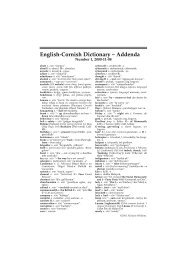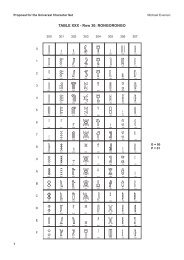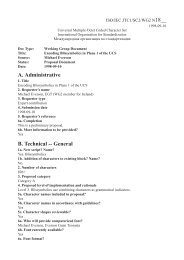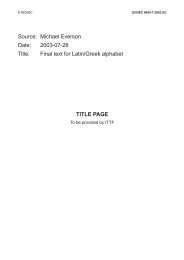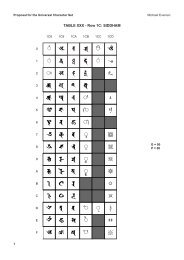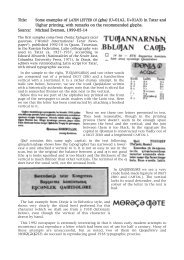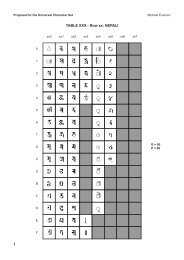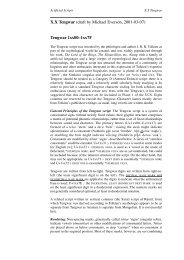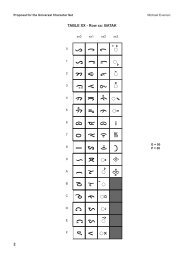Representing Myanmar in Unicode - Evertype
Representing Myanmar in Unicode - Evertype
Representing Myanmar in Unicode - Evertype
Create successful ePaper yourself
Turn your PDF publications into a flip-book with our unique Google optimized e-Paper software.
<strong>Unicode</strong> 5.1 Model<br />
Basic <strong>Myanmar</strong><br />
The basic consonants and vowels are relatively obvious <strong>in</strong> how they are encoded, by exam<strong>in</strong><strong>in</strong>g the character<br />
charts. Thus:<br />
စာ 1005 102C letter<br />
Above we show the <strong>Myanmar</strong> word, the underly<strong>in</strong>g <strong>Unicode</strong> codes that would be stored to represent this and<br />
an English gloss of the word. As this example shows, characters are stored <strong>in</strong> the order <strong>in</strong> which they are<br />
read.<br />
ခါ 1001 102B to shake<br />
သိက္ာ<br />
101E 102D 1000 1039 1001<br />
102C<br />
dignity<br />
သဒ္ါ 101E 1012 1039 1013 102B faith<br />
In this example, we highlight the code of <strong>in</strong>terest. Notice how the ါါ (U+102B MYANMAR VOWEL SIGN TALL<br />
AA) has a different code to the ါာ (U+102C MYANMAR VOWEL SIGN AA). The <strong>Myanmar</strong> character underly<strong>in</strong>g<br />
the two codes is the same, and there are render<strong>in</strong>g rules that can give the correct form, so why has the tall -aa<br />
been given its own code? The primary reason is that Sgaw Karen, among other m<strong>in</strong>ority scripts, only has the<br />
tall form, and so a render<strong>in</strong>g system that works for the <strong>Myanmar</strong> language is not go<strong>in</strong>g to work for Sgaw<br />
Karen and vice versa. A <strong>Myanmar</strong> language specific keyboard<strong>in</strong>g implementation could choose to enforce a<br />
particular variant of the -aa vowel <strong>in</strong> the context of certa<strong>in</strong> consonants (<strong>in</strong> Burmese follow<strong>in</strong>g ခ, ဂ, င, ဒ, ပ, or<br />
ဝ), medial comb<strong>in</strong>ations and syllable cha<strong>in</strong><strong>in</strong>gs, but this is not required.<br />
ညို 100A 102D 102F brown<br />
ထုံ း 1011 102F 1036 1038 to tie<br />
Notice how the two forms of ါု (U+102F MYANMAR VOWEL SIGN U) have the same code. It is up to the<br />
render<strong>in</strong>g system to choose which form should be shown and different fonts can have different rules<br />
depend<strong>in</strong>g on the designer’s preference.<br />
U+1031 –e vowel<br />
We will see later why the vowels are stored <strong>in</strong> this relative order. But for now it is important to note that the<br />
<strong>Unicode</strong> standard states that vowels are stored after the consonant, accord<strong>in</strong>g to how they are read,<br />
regardless of where they are rendered. This <strong>in</strong>troduces one of the complexities of implement<strong>in</strong>g <strong>Myanmar</strong><br />
script:<br />
နန 1014 1031 the sun<br />
နပါ 1015 1031 102B plentiful<br />
The နါ vowel is rendered <strong>in</strong> front of the consonant that it is pronounced (and so stored) follow<strong>in</strong>g. Notice<br />
that this says noth<strong>in</strong>g about the relative order for typ<strong>in</strong>g, but it does mean that anyone implement<strong>in</strong>g the<br />
<strong>Myanmar</strong> script needs to take special care of this character. In general people are used to and want to type<br />
the န vowel <strong>in</strong> front of the consonant, and so implementors need to address issues of keyboard<strong>in</strong>g as well as<br />
render<strong>in</strong>g.<br />
Medials<br />
The medial characters have their own codes and are always stored after the base consonant and before any<br />
vowels. Although the character ြါ has traditionally been typed <strong>in</strong> non-<strong>Unicode</strong> fonts before the consonant, it<br />
is consistent with normal spell<strong>in</strong>g to store U+103C MYANMAR CONSONANT SIGN MEDIAL RA after the<br />
consonant.<br />
<strong>Represent<strong>in</strong>g</strong> <strong>Myanmar</strong> <strong>in</strong> <strong>Unicode</strong> Page 3 of 37 Version: 433





